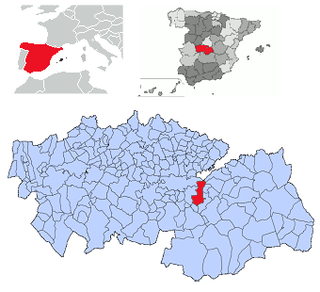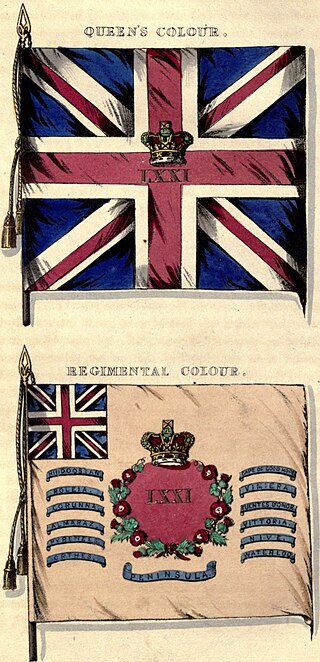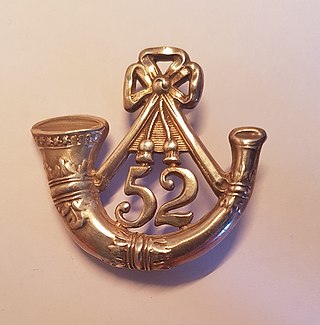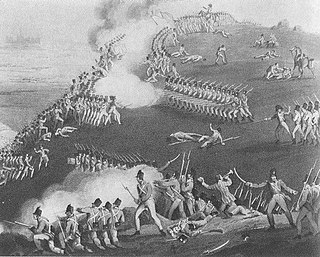
The Battle of Almonacid was fought on 11 August 1809 during the Peninsular War between Sébastiani's IV Corps of the French Peninsular Army, which King Joseph of Spain had withdrawn from the Battle of Talavera to defend Madrid, and the Spanish Army of La Mancha under General Venegas. After the decisive charges of Polish uhlans, the battle resulted in a French victory.

Field Marshal Sir Charles (Carl) August von Alten was a Hanoverian and British soldier who led the famous Light Division during the last two years of the Peninsular War. At the Battle of Waterloo, he commanded a division in the front line, where he was wounded. He later rose to the rank of Field Marshal in the Hanoverian Army.

The Battle of Corunna, in Spain known as Battle of Elviña, took place on 16 January 1809, when a French corps under Marshal of the Empire Jean de Dieu Soult attacked a British army under Lieutenant-General Sir John Moore. The battle took place amidst the Peninsular War, which was a part of the wider Napoleonic Wars. It was a result of a French campaign, led by Napoleon, which had defeated the Spanish armies and caused the British army to withdraw to the coast following an unsuccessful attempt by Moore to attack Soult's corps and divert the French army.

The Battle of Somosierra took place on 30 November 1808, during the Peninsular War, when a combined Franco-Spanish-Polish force under the direct command of Napoleon Bonaparte forced a passage through a Spanish Division stationed at the Sierra de Guadarrama, which shielded Madrid from direct French attack. At the Somosierra mountain pass, 60 miles (97 km) north of Madrid, a heavily outnumbered Spanish detachment of regulars, volunteers and artillery under Benito de San Juan aimed to block Napoleon's advance on the Spanish capital. Napoleon overwhelmed the Spanish positions in a combined arms attack, sending the Polish Chevau-légers of the Imperial Guard at the Spanish guns while French infantry advanced up the slopes. The victory removed the last obstacle barring the road to Madrid, which fell several days later.

The 50th Regiment of Foot was an infantry regiment of the British Army, raised in 1755. Under the Childers Reforms it amalgamated with the 97th Regiment of Foot to form the Queen's Own Royal West Kent Regiment in 1881.

The 71st Regiment of Foot was a Highland regiment in the British Army, raised as the 73rd (Highland) Regiment of Foot in 1777. Under the Childers Reforms it amalgamated with the 74th (Highland) Regiment of Foot to become the 1st Battalion, Highland Light Infantry in 1881.

The 81st Regiment of Foot (Loyal Lincoln Volunteers) was an infantry regiment of the British Army, raised in 1793. Under the Childers Reforms it amalgamated with the 47th (Lancashire) Regiment of Foot to form the Loyal North Lancashire Regiment in 1881.

The 15th The King's Hussars was a cavalry regiment in the British Army. First raised in 1759, it saw service over two centuries, including the First World War, before being amalgamated with the 19th Royal Hussars into the 15th/19th The King's Royal Hussars in 1922.
The 51st Regiment of Foot was a British Army line infantry regiment, raised in 1755. Under the Childers Reforms it amalgamated with the 105th Regiment of Foot to form the King's Own Yorkshire Light Infantry in 1881.

The 52nd (Oxfordshire) Regiment of Foot was a light infantry regiment of the British Army throughout much of the 18th and 19th centuries. The regiment first saw active service during the American War of Independence, and were posted to India during the Anglo-Mysore Wars. During the Napoleonic Wars, the 52nd were part of the Light Division, and were present at most major battles of the Peninsula campaign, becoming one of the most celebrated regiments, described by Sir William Napier as "a regiment never surpassed in arms since arms were first borne by men". They had the largest British battalion at Waterloo, 1815, where they formed part of the final charge against Napoleon's Imperial Guard. They were also involved in various campaigns in India.

At the siege of Burgos, from 19 September to 21 October 1812, the Anglo-Portuguese Army led by General Arthur Wellesley, Marquess of Wellington tried to capture the castle of Burgos from its French garrison under the command of General of Brigade Jean-Louis Dubreton. The French repulsed every attempt to seize the fortress, resulting in Wellington's withdrawal. The siege took place during the Peninsular War, part of the Napoleonic Wars. Burgos is located about 210 kilometres (130 mi) north of Madrid.
This is the order of battle for the Battle of Albuera. The Battle of Albuera was an engagement of the Peninsular War, fought between a mixed British, Spanish, and Portuguese corps and elements of the French Armée du Midi. It took place at the small Spanish village of Albuera, about 12 miles (20 km) south of the frontier fortress-town of Badajoz, Spain. Marshal Sir William Beresford had been given the task of reconstructing the Portuguese army since February 1809. He temporarily took command of General Rowland Hill's corps while Hill was recovering from illness, and was granted overall command of the Allied army at Albuera by the Spanish generals, Joaquín Blake y Joyes and Francisco Castaños.

In the Battle of Castalla on 13 April 1813, an Anglo-Spanish-Sicilian force commanded by Lieutenant General Sir John Murray fought Marshal Louis Gabriel Suchet's French Army of Valencia and Aragon. Murray's troops successfully repelled a series of French attacks on their hilltop position, causing Suchet to retreat. The action took place during the Peninsular War, part of the Napoleonic Wars. Castalla is located 35 kilometers north-northwest of Alicante, Spain.

The Battle of Benavente was a cavalry clash in which the British cavalry of Lord Paget defeated the elite Chasseurs à cheval of the French Imperial Guard during the Corunna Campaign of the Peninsular War. The French chasseurs were broken and forced into the River Esla; their commanding officer, General Lefebvre-Desnouettes, was captured. The action was the first major incident in the British army's harrowing retreat to the coast and ultimate evacuation by sea.
The Battle of Toulouse saw a French army led by Marshal Nicolas Soult defend the city of Toulouse against the Marquess of Wellington's British, Portuguese, and Spanish army. The fighting took place on 10 April 1814 and Soult evacuated the city late in the evening of 11 April after suffering defeat. Allied casualties in the bitter fighting exceeded French losses by more than a thousand. Official news of the end of the war did not reach Wellington until the afternoon of 12 April.

In the Battle of Tordesillas, Battle of Villa Muriel or Battle of Palencia between 25 and 29 October 1812, a French army led by Joseph Souham pushed back an Anglo-Portuguese-Spanish army commanded by Arthur Wellesley, Marquess Wellington. After its failed Siege of Burgos, the 35,000-man Allied army withdrew to the west, pursued by Souham's 53,000 French soldiers. On 23 October, French cavalry defeated the Allied rear guard in the Battle of Venta del Pozo. The Allies pulled back behind the Pisuerga and Carrión Rivers and took up a defensive position.
This is the order of battle for the Battle of Vitoria.

The Battle of Talavera saw an Imperial French army under King Joseph Bonaparte and Marshal Jean-Baptiste Jourdan attack a combined British and Spanish army led by Sir Arthur Wellesley. After several of their assaults were bloodily repulsed on the second day, the French retreated toward Madrid leaving the battlefield to the Anglo-Spanish army. Events soon compelled Wellesley, who was soon appointed Viscount Wellington, to fall back toward his base in Portugal. The following units and commanders fought at the battle, which occurred during the Peninsular War.
This is the order of battle for the Battle of Bussaco, 27 September 1810.
This is the order of battle for the Battle of Fuentes de Oñoro, which took place on 3–6 May 1811.













